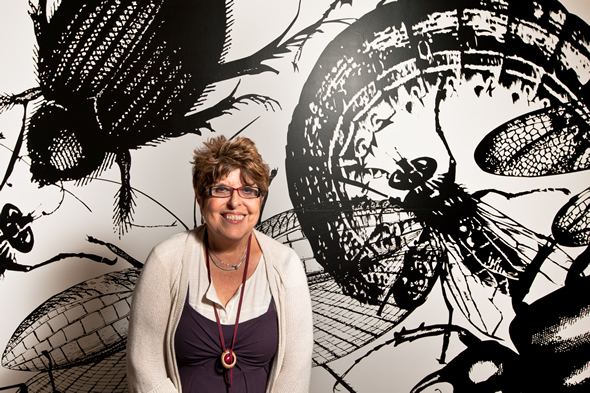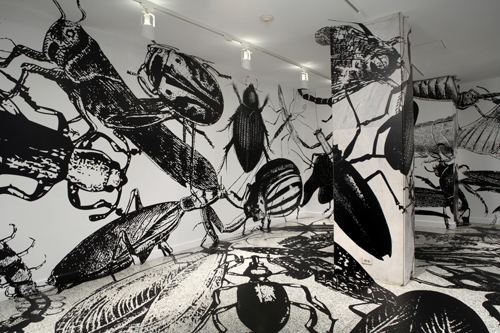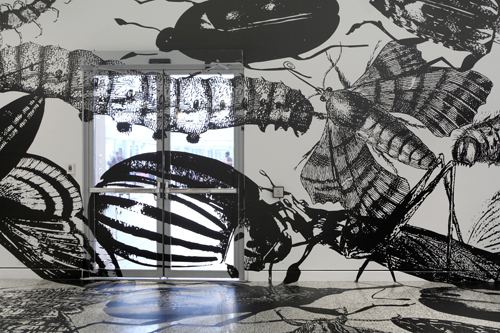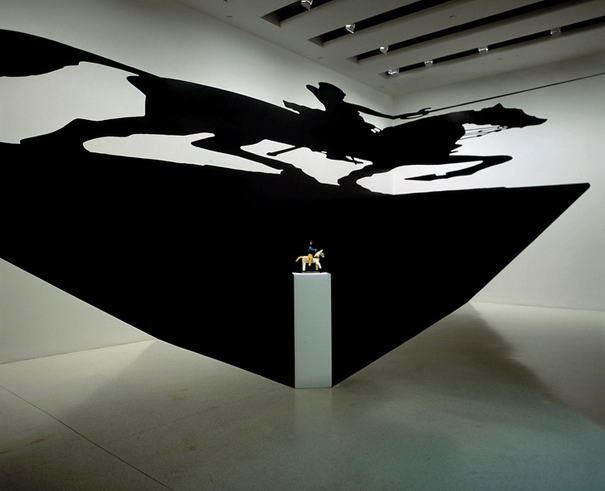 | ||
Books Regina Silveira: Limits & in Absentia (collection). Awards Guggenheim Fellowship for Creative Arts, Latin America & Caribbean | ||
Mundus admirabilis regina silveira
Regina Silveira an internationally known Brazilian artist, works with light, shadows and distortions to explore ideas of reality. She also loves to play with the perceptions of physical space and continuity within her work. She has used many media throughout her career but focuses mainly on videography, painting, and printmaking (including some lithography.) Living, working, and learning mainly in São Paulo throughout her life, she can be considered one of the most influential Latin American female artists of her generation. She aims to make the viewer actually think about her works, and about how they are literally viewing them.
Contents
- Mundus admirabilis regina silveira
- Regina silveira mundus admirabilis
- Early life
- Education
- Employment
- Work themes and processes
- Solo exhibitions
- Notable Exhibitions Detailed
- Awards
- References

Regina silveira mundus admirabilis
Early life
Silveira was born in Porto Alegre, Brazil but has spent much of her life in the city of São Paulo. She began studying art in 1950 under Brazilian painter Ibere Camargo; she studied lithography and woodcut in addition to painting. In the 1970s, she began experimenting with printmaking and video.
Education

Regina graduated at the young age of 20 in 1959 with a degree in fine arts from the Arts Institute of the Universidade Federal do Rio Grande do Sul. From there she went on to begin a career, and in the mean time she worked on completing her Master of Fine Arts degree in 1980 and furthermore received her PhD from the University of São Paulo's School of Communication and Arts. in 1984. Although her education seemed to come to an end at this point in her life, Silveira continued to hold employment at many educational institutions throughout the region in the next few decades following her final graduation, which would allow her to continually keep up with the "artist's realm" as it were, adding to her ability to perfect her niche of the craft.
Employment
Regina Silveira held positions at many universities throughout her career. The first was at the Arts Institute of the Universidade Federal do Rio Grande do Sul, an institution from which she graduated with her Bachelor of Fine Arts from 1964 until 1969. From there she took a position at the University of Puerto Rico on the Mayagyeaz Campus from 1969 for four years until 1973 when she accepted a position at the Fundação Armando Alvares Penteado (FAAP-SP). She kept this position for just over ten years from 1973 until 1985 when she once again found a new employment opportunity. Silveira retired after a lengthy career from the Department of Plastic Arts from the School of Communications and Arts at the Universidade de São Paulo.
Work: themes and processes

Her art images use installation printmaking in conceptual ways. Silveira's early paintings were site-specific on walls, which then developed into illusions that incorporate digitally produced images in walls and rooms. Silveira has used printmaking tor explore the impact of distortion with confrontational shadow images.

Silveira’s work centers around the idea that there is a tension between movement and the spatial perspective of an individual, which allows her to interpret her ideas and themes in whatever format she chooses; sometimes she likes to tie in political connotations in order to give a deeper meaning to her work.
In Absentia (1983), was presented at the 17th Biennial in Sao Paulo. The work, two silhouettes of two of Marcel Duchamp’s "readymades" filled the room with shadows in deformed perspectives missing the source of the objects with empty pedestals.
Silveira‘s visual vocabulary explores the Simulacros between absence and presence using shadows, footprints, and tire tracks.
Silveira has had many international installations. She is known for her novel uses of museum and gallery spaces and for her installations in empty office spaces in Houston, Texas. Furthermore, not only does she experiment with the idea of space and how it is perceived, she also works with light, and the absence of light (shadow.)Her exploration of shadow and light and how that relates to objects are implied and engulfing to the viewer. She likes how shadows are intangible and therefore are in nature a very moldable part of her work that can be intentionally distorted and allow a certain image to only be viewed when looked at from a unique angle. She likes the ideas related to whether something is present or absent from a scene as well. Desaparencia, from YEAR, literally depicts an easel and stool using dotted lines which is supposed to indicate that although they are present as the piece of art, they are not actually present in the scene, leading to an interesting dichotomy for the viewer.
Silveira is represented by the Sicardi Gallery in Houston, Texas. She resides and works in São Paulo, Brazil.
Solo exhibitions
Regina Silveira also took part in many group exhibitions such as the 1st Havana Biennial (Cuba, 1984); Brazil: Body and Soul, Guggenheim Museum (New York, 2001); the XV Bienial de Cerveira (Vila Nova de Cerveira, Portugal, 2009); Philagrafika (Philadelphia, 2010); and the XI Biennial of Cuenca (Ecuador, 2011).
Notable Exhibitions (Detailed)
Regina Silveira has hosted and contributed to over 100 exhibitions throughout her illustrious career.
Lumen is a favorite of many. Silveira took an entire glass-building and she placed a vinyl lightbulb on the façade which was dark during the day, but had the ability to light up at night. She also utilized blue glass additions which caused the building to have a very different look than its original style, and it also managed to cast shadows and patterns onto the floor which was exactly what Regina Silveira wanted.
Gone Wild is an exhibition which featured animal paw prints in vinyl pasted on the walls. The paw prints appear as though they begin on the floor in amorphous shapes and lead onto the walls as if an animal were actually running around the room. Many of the prints are distorted so that they can only be viewed as a ‘normal’ paw print when viewed from a certain angle.
Desaparencia is a piece that is set in a barren white-walled room with cedar flooring. The walls have windows, but they are closed so they add little to the effect of the piece. Silveira took latex and using dotted lines, she outlined an artist’s easel holding a piece of canvas, with a stool by its side. The easel and the stool extend from the floor (the picture of the piece makes it appear that it may be from the door or from the point of view representing the feet of the viewer) up onto the walls and towards the ceiling. It looks much larger than life, while at the same time very normal. Although it extends from beyond the bottom of the wall all the way towards the ceiling, if looked at from the correct position, it would seem to appear a very regular size.
Mil E Um Dias is one of my personal favorites. Silveira painted two scenes on a plain wall which also included a doorway and stairs. The two scenes included one night sky dotted with stars, and the other is a picture of a cloudy morning with sunlight peeking through. The door seems to seamlessly blend in with the walls, and the only architecture which draws the eyes of the viewers away from the actual paintings are the stairs. The stairs appear to be leading into non-existent doorways in the sky. It really leads to a deeper understanding and also a deeper contemplation of the meaning of the piece; it’s two-fold really: the wall is the blank canvas of our future and we are always trying to make it up the staircase into what lies ahead.
Mundus Admirabilis features vinyl insects taking over a two-tiered room with white walls. This seems to be a repeating pattern throughout Regina’s work – white walls with black vinyl patterns. In this piece, she shows hundreds of larger-than-life insects taking over the entire room. They can be found on the ground, on the walls, and even climbing the ladder to the second floor balcony of the room. Although these insects are crawling between the walls, floors, and on the metal seams throughout the room, when looked at as a whole, they don’t seem to be segmented, that is to say they don’t look like they are crossing the seams of the walls where they meet the flooring, nor do they appear to break between the steps of the ladder.
Awards
In recent years, Regina Silveira has won several awards for her amazing work. This list is not exhaustive, but includes many awards between the years of 1983 and 2013.
